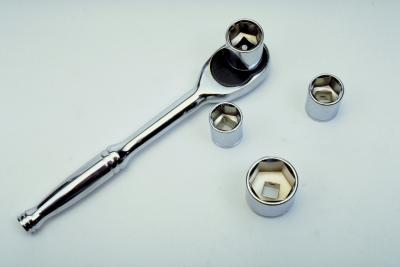
The anti-lock braking system, or ABS, in your vehicle helps to prevent wheel lock up though a sensor that is mounted at each wheel that monitors wheel speed. When the sensor "sees" that the wheel locks up during hard braking, the sensor automatically releases brake pressure momentarily and begins pumping the brakes for you at a very rapid pace. The pumping action of the ABS system is much faster than what you would ever be able to do manually and allows you to better control the vehicle during hard braking. When these sensors fail, your ABS system will no longer work until you replace the faulty sensor. Replacement sensors can be purchased from most auto parts stores.
Open the hood and loosen the retaining nut on the cable clamp connected to the negative battery terminal. Then slide the clamp off the negative battery terminal to cut power to all of the ABS sensors.
Turn the wheel lug nuts counterclockwise with a tire wrench 1/4 turn. Do not unseat the wheel from the wheel hub, however. You only need to break the lug nuts loose so that it is easier to remove the wheel once it is up off the ground.
Raise the vehicle onto jack stands. Lift up on the front jack point of the vehicle located behind the radiator using a floor jack. The jack point will normally be the front cross-member or an extension of the frame of the vehicle used specifically as a jack point. Place jack stands underneath the front pinch welds of the vehicle, located underneath the driver and passenger side doors, and lower the vehicle onto the jack stands.
Finish removing the wheel lug nuts and pull the wheel off the wheel hub assembly.
Locate the ABS sensor on the wheel hub assembly. Normally, this will look like a small black box mounted to the wheel hub.
Unplug the electrical wiring from the ABS sensor.
Remove the screws or bolts that hold your ABS sensor in place and pull the sensor off the hub with a screwdriver or socket wrench.
Align the mounting holes on the new sensor with the mounting holes on the wheel hub for the new ABS sensor.
Thread and tighten the bolts or screws.
Plug the electrical connector back into the ABS sensor.
Mount the wheel and tighten the lug nuts with a tire wrench.
Lower the vehicle to the ground and tighten the wheel lug nuts to between 75 and 100 foot-pounds, depending on the vehicle's wheel lug nut torque specifications, using a torque wrench.